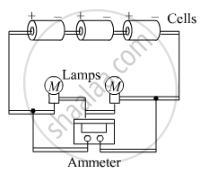Advertisements
Advertisements
Question
Find the potential difference required to pass a current of 0.2 A in a wire of resistance 20Ω
Solution
Current (I) = 0.2 A
Resistance (R) = 20 ohm
Potential Difference (V) = ?
According to Ohm's Law :
V = IR
V = 0.2 × 20 = 4 V
APPEARS IN
RELATED QUESTIONS
Choose the correct alternative and rewrite the following sentence.
When the resistance of a conductor increases, the current will ________ increase.
A student made an electric circuit shown here to measure the current through two lamps.
Are the lamps in series or parallel?
(a) Are the lamps in series or parallel?
(b) The student has made a mistake in this circuit. What is the mistake?
(c) Draw a circuit diagram to show the correct way to connect the circuit. Use the proper circuit symbols in your diagram.

In the circuit diagram given below, three resistors R1, R2, and R3 of 5 Ω, 10 Ω and 30 Ω, respectively are connected as shown

Calculate:
- current through each resistor.
- total current in the circuit.
- total resistance in the circuit.
How do you think the brightness of two lamps arranged in parallel compares with the brightness of two lamps arranged in series (both arrangements having one cell)?
State the S.I. unit of current.
Explain with the help of a diagram how does 'short circuiting' occur in an electric kettle.
Fill in the blank :
1 mA = ............................. A.
What should I choose ___________________
b. for getting protection from electric current.
c. to measure the current in the circuit?
An electric bulb is marked 100 W, 250 V. How much current will the bulb draw if connected to a 250 V supply?
